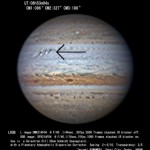NASA just released a new image of Jupiter that confirms what amateur astronomers discovered a few days ago: Jupiter’s Southern Equatorial Belt is coming back!
[Click to enzeusenate.]
This picture is a combination of three infrared images using the monster Gemini North Telescope. Infrared light at 1.69 microns (roughly twice the wavelength our eyes can see) is colored yellow, and shows the cloudtops, much like optical light images show. Far-infrared at 4.68 microns (wavelengths roughly 5-6 times what our eyes can see) is colored red, and comes from two altitudes: high up in the clouds where convected heat from the interior comes up, as well as from areas with little cloud cover allowing us to see the ambient heat from deeper in the atmosphere. Blue represents 2.12 microns (~2.5x what our eyes perceive) and comes from particles suspended high above the cloud deck.
 The Southern Equatorial Belt is usually dark, and is somewhat lower down in Jupiter’s atmosphere than other clouds. Every now and again the wind patterns change, and white ammonia ice forms above the belt, hiding it. That pattern stays around for a while, then eventually breaks up. As that happens, we get patches of clearer air, allowing us to see down into the atmosphere farther, where the dark belt still lies.
The Southern Equatorial Belt is usually dark, and is somewhat lower down in Jupiter’s atmosphere than other clouds. Every now and again the wind patterns change, and white ammonia ice forms above the belt, hiding it. That pattern stays around for a while, then eventually breaks up. As that happens, we get patches of clearer air, allowing us to see down into the atmosphere farther, where the dark belt still lies.
That’s what’s happening here. The NASA image looks very much like those taken by amateur astronomers recently (shown here on the right)*. You can see the three dark comma-shaped features in the amateur image, which astronomers suspected were clear patches through the white ammonia ice, letting us peek at the lower-altitude belt below them. In the infrared those patches are bright, just as you’d expect from the warmer belt air, supporting the idea that the ammonia fog is clearing and the belt is ready to come back into view.
All in all, what astronomers are hoping is that we’ve caught the re-emergence of the belt as it’s happening: something never seen before with modern high-tech instrumentation.
And it’s very important to note how this was found: by dedicated amateur astronomers who watch Jupiter like hawks with every chance they get. Christopher Go, who first saw a bright spot on Jupiter signifying the belt’s return, was watching for it specifically: he knew from the last time the belt disappeared what to look for. And he should know what Jupiter looks like, since he monitors it constantly, and in fact actually caught the flash of light from an asteroid impact on Jupiter in June 2010.
Astronomy is an awesome science: it’s one of the few where dedicated “hobbyists” can contribute, and do so in a critical and timely way. It’s a big sky, with a lot to observe. And if I may say so, I’m thankful there are so many keeping an eye on it.
* Though you have to be careful; the two images show different things in different colors, so a cloud layer that is dark in one image may be bright in another.
Related posts:
- Jupiter hitching up its belt?
- BREAKING: Another Jupiter impact!
- FOLLOWUP: Jupiter impact video and a color picture